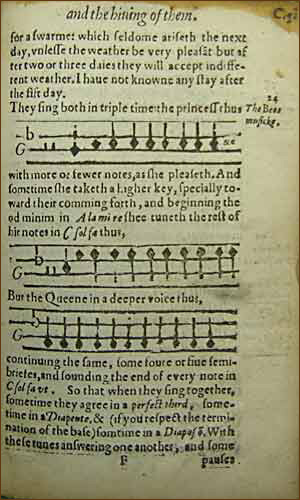The 'piping' and 'quacking' of queen bees


Charles Butler was a highly original scholar whose books included a treatise on bees entitled 'The feminine monarchie', shown here in both the 1609 and 1634 editions. In this work Butler attempted to transcribe into musical notation the 'piping' and 'quacking' sounds produced by rival queens within a hive. Quacking is the responsive sound of rival queens who have not yet emerged from their cells, and piping is the regal identification of a virgin queen soon after she has emerged from the cell in which she developed.
The 1609 edition shows a four line staff with the letter G on the second line from the bottom indicating that this is a treble clef. There are no bar lines but the two semibreve rests at the beginning of the staves indicate that we are in a triple metre, and indeed the text states that the bees 'sing' in triple time. The notation indicates that the two most common results of the simultaneous piping and quacking of the rival queens are the musical intervals of either a perfect fifth or a major third.
Image (top left): Charles Butler. 'The feminine monarchie or a treatise concerning bees, and the due ordering of them'. Oxford, 1609. [NLS shelfmark: MRB.13]
The 1634 edition presents a two-part madrigal for four voices incorporating melodic elements based on the actual sounds produced by bees. The music has been printed in the manner of a part-book to be read by the Mean [soprano] and Tenor sitting on one side of a table and by the Bassus and Countertenor facing them on the other side. This edition also incorporates the use of what is referred to as 'Butler's reformed spelling'. In his 'English grammar' of the previous year (1633), Butler had condemned the vagaries of English orthography and proposed the adoption of a system whereby 'men should write altogether according to the sound now generally received'.
Image (bottom left): Charles Butler. 'The feminin' monarch', or the histori of bee's [reformed spelling]'. Oxford, 1634. [NLS shelfmark: MRB.135]